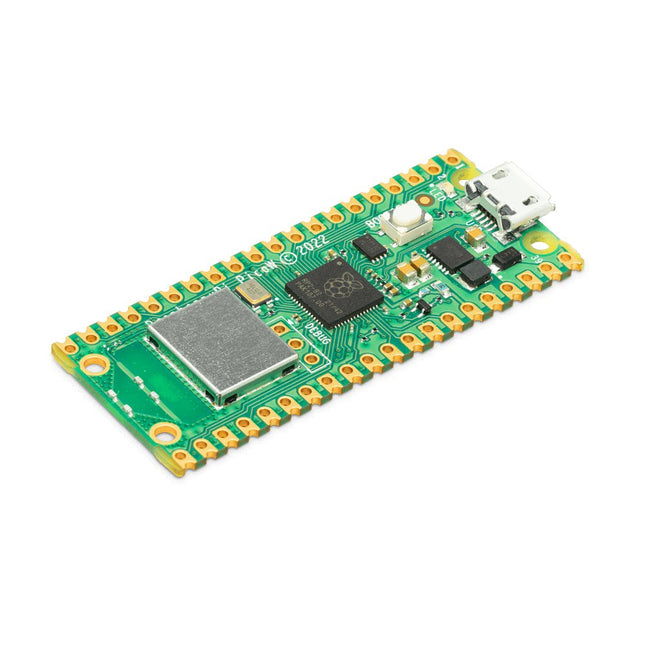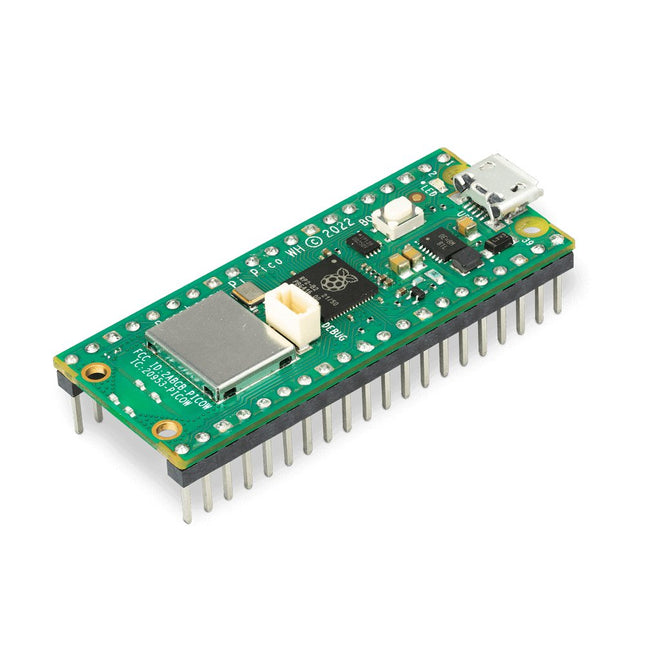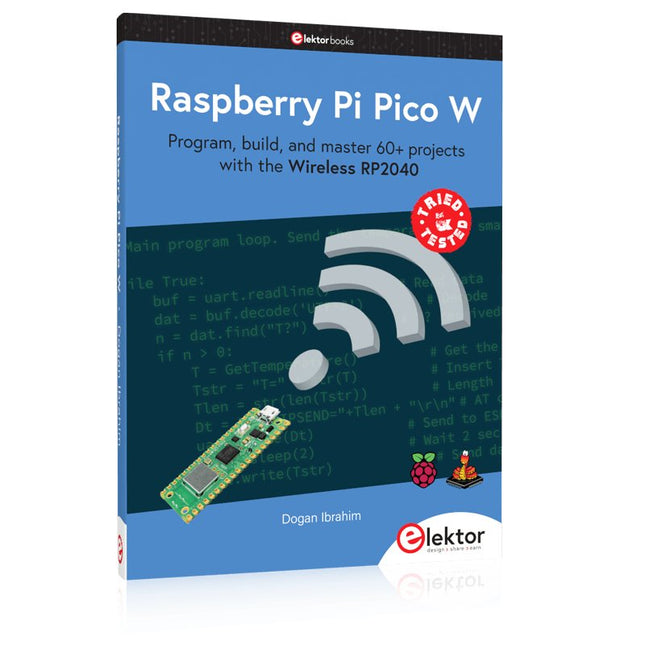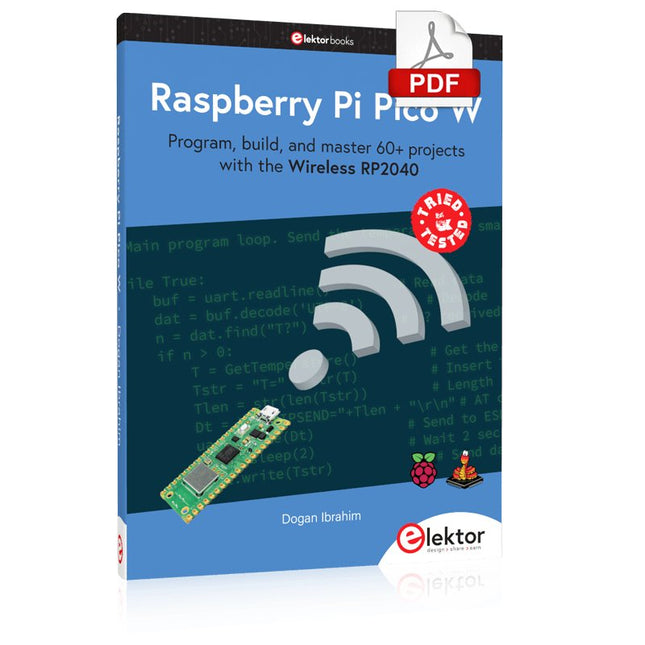Suchergebnisse für "infineon"
-

Raspberry Pi Foundation Raspberry Pi Pico 2 W
Der Raspberry Pi Pico 2 W ist ein Mikrocontroller-Board auf Basis des RP2350 mit 2,4 GHz 802.11n Wireless LAN und Bluetooth 5.2. Es gibt Ihnen noch mehr Flexibilität bei Ihren IoT- oder Smart-Produktdesigns und erweitert die Möglichkeiten für Ihre Projekte. Der RP2350 bietet eine umfassende Sicherheitsarchitektur rund um Arm TrustZone für Cortex-M. Es umfasst signiertes Booten, 8 KB Antifuse-OTP für die Schlüsselspeicherung, SHA-256-Beschleunigung, einen Hardware-TRNG und schnelle Glitch-Detektoren. Die einzigartige Dual-Core- und Dual-Architektur-Fähigkeit des RP2350 ermöglicht Benutzern die Wahl zwischen einem Paar ARM Cortex-M33-Kernen nach Industriestandard und einem Paar Hazard3 RISC-V-Kernen mit offener Hardware. Der Raspberry Pi Pico 2 W ist in C/C++ und Python programmierbar und wird durch eine ausführliche Dokumentation unterstützt. Er ist das ideale Mikrocontroller-Board sowohl für Enthusiasten als auch für professionelle Entwickler. Technische Daten CPU Dual Arm Cortex-M33 oder Dual RISC-V Hazard3 Prozessoren bei 150 MHz Wireless On-Board Infineon CYW43439 Single-Band 2,4 GHz 802.11n Wireless Lan und Bluetooth 5.2 Speicher 520 KB On-Chip-SRAM; 4 MB integrierter QSPI-Flash Schnittstellen 26 Mehrzweck-GPIO-Pins, darunter 4, die für AD verwendet werden können Peripherie 2x UART 2x SPI-Controller 2x I²C-Controller 24x PWM-Kanäle 1x USB 1.1-Controller und PHY, mit Host- und Geräteunterstützung 12x PIO-Zustandsmaschinen Eingangsspannung 1,8-5,5 V DC Abmessungen 21 x 51 mm Downloads Datasheet Pinout Schematic
€ 7,95
Mitglieder identisch
-

Raspberry Pi Foundation Raspberry Pi Pico W
Raspberry Pi Pico W ist ein Mikrocontroller-Board, das auf dem Mikrocontroller-Chip Raspberry Pi RP2040 basiert. Der Mikrocontroller-Chip RP2040 ("Raspberry Silicon") bietet einen Dual-Core-ARM-Cortex-M0+-Prozessor (133 MHz), 256 KB RAM, 30 GPIO-Pins und viele andere Schnittstellenoptionen. Darüber hinaus gibt es 2 MB integrierten QSPI-Flash-Speicher für Code- und Datenspeicherung. Raspberry Pi Pico W wurde als kostengünstige und dennoch flexible Plattform für RP2040 mit einer drahtlosen 2,4-GHz-Schnittstelle unter Verwendung eines Infineon CYW43439 entwickelt. Die Funkschnittstelle wird über SPI mit dem RP2040 verbunden. Features von Pico W RP2040-Mikrocontroller mit 2 MB Flash-Speicher Integrierte 2,4-GHz-Single-Band-Wireless-Schnittstellen (802.11n) Micro-USB-B-Anschluss für Strom und Daten (und zur Neuprogrammierung des Flash) 40-polige 21 x 51 mm 'DIP'-Stil, 1 mm dicke PCB mit 0,1" Durchgangslochstiften, auch mit Randkerben Bietet 26 multifunktionale 3,3-V-Universal-I/O (GPIO) 23 GPIO sind rein digital, wobei drei auch ADC-fähig sind Kann als Modul auf der Oberfläche montiert werden 3-poliger ARM Serial Wire Debug (SWD) Port Einfache, aber hochflexible Stromversorgungsarchitektur Verschiedene Optionen zur einfachen Stromversorgung des Geräts über Micro-USB, externe Netzteile oder Batterien Hohe Qualität, niedrige Kosten, hohe Verfügbarkeit Umfassendes SDK, Softwarebeispiele und Dokumentation Features von RP2040-Mikrocontroller Dual-Core-Cortex M0+ mit bis zu 133 MHz On-Chip-PLL ermöglicht eine variable Kernfrequenz 264 kByte Multibank-Hochleistungs-SRAM Externer Quad-SPI-Flash mit eXecute In Place (XIP) und 16 KB On-Chip-Cache Hochleistungs-Full-Crossbar-Busgewebe On-Board USB1.1 (Gerät oder Host) 30 Multifunktions-Allzweck-I/O (vier können für ADC verwendet werden) 1,8-3,3 V I/O-Spannung 12-Bit 500 ksps Analog-Digital-Wandler (ADC) Verschiedene digitale Peripheriegeräte 2x UART, 2x I²C, 2x SPI, 16x PWM-Kanäle 1 Timer mit 4 Alarmen, 1 Echtzeituhr 2x programmierbare I/O-Blöcke (PIO), insgesamt 8 Zustandsmaschinen Flexible, benutzerprogrammierbare Hochgeschwindigkeits-I/O Kann Schnittstellen wie SD-Karte und VGA emulieren Hinweis: Raspberry Pi Pico W I/O-Spannung ist auf 3,3 V festgelegt. Downloads Datasheet Specifications of 3-pin Debug Connector
€ 7,95
Mitglieder identisch
-

Raspberry Pi Foundation Raspberry Pi Pico WH
Raspberry Pi Pico W ist ein Mikrocontroller-Board, das auf dem Mikrocontroller-Chip Raspberry Pi RP2040 basiert. Der Mikrocontroller-Chip RP2040 ("Raspberry Silicon") bietet einen Dual-Core-ARM-Cortex-M0+-Prozessor (133 MHz), 256 KB RAM, 30 GPIO-Pins und viele andere Schnittstellenoptionen. Darüber hinaus gibt es 2 MB integrierten QSPI-Flash-Speicher für Code- und Datenspeicherung. Raspberry Pi Pico W wurde als kostengünstige und dennoch flexible Plattform für RP2040 mit einer drahtlosen 2,4-GHz-Schnittstelle unter Verwendung eines Infineon CYW43439 entwickelt. Die Funkschnittstelle wird über SPI mit dem RP2040 verbunden. Features von Pico WH RP2040-Mikrocontroller mit 2 MB Flash-Speicher Integrierte 2,4-GHz-Single-Band-Wireless-Schnittstellen (802.11n) Micro-USB-B-Anschluss für Strom und Daten (und zur Neuprogrammierung des Flash) 40-polige 21 x 51 mm 'DIP'-Stil, 1 mm dicke PCB mit 0,1" Durchgangslochstiften, auch mit Randkerben Bietet 26 multifunktionale 3,3-V-Universal-I/O (GPIO) 23 GPIO sind rein digital, wobei drei auch ADC-fähig sind Kann als Modul auf der Oberfläche montiert werden 3-poliger ARM Serial Wire Debug (SWD) Port Einfache, aber hochflexible Stromversorgungsarchitektur Verschiedene Optionen zur einfachen Stromversorgung des Geräts über Micro-USB, externe Netzteile oder Batterien Hohe Qualität, niedrige Kosten, hohe Verfügbarkeit Umfassendes SDK, Softwarebeispiele und Dokumentation Features von RP2040-Mikrocontroller Dual-Core-Cortex M0+ mit bis zu 133 MHz On-Chip-PLL ermöglicht eine variable Kernfrequenz 264 kByte Multibank-Hochleistungs-SRAM Externer Quad-SPI-Flash mit eXecute In Place (XIP) und 16 KB On-Chip-Cache Hochleistungs-Full-Crossbar-Busgewebe On-Board USB1.1 (Gerät oder Host) 30 Multifunktions-Allzweck-I/O (vier können für ADC verwendet werden) 1,8-3,3 V I/O-Spannung 12-Bit 500 ksps Analog-Digital-Wandler (ADC) Verschiedene digitale Peripheriegeräte 2x UART, 2x I²C, 2x SPI, 16x PWM-Kanäle 1 Timer mit 4 Alarmen, 1 Echtzeituhr 2x programmierbare I/O-Blöcke (PIO), insgesamt 8 Zustandsmaschinen Flexible, benutzerprogrammierbare Hochgeschwindigkeits-I/O Kann Schnittstellen wie SD-Karte und VGA emulieren Hinweis: Raspberry Pi Pico W I/O-Spannung ist auf 3,3 V festgelegt. Downloads Datasheet Specifications of 3-pin Debug Connector
€ 9,95
Mitglieder identisch
-

Raspberry Pi Foundation Raspberry Pi Pico 2 WH
Der Raspberry Pi Pico 2 WH (mit Header) ist ein Mikrocontroller-Board auf Basis des RP2350 mit 2,4 GHz 802.11n Wireless LAN und Bluetooth 5.2. Es gibt Ihnen noch mehr Flexibilität bei Ihren IoT- oder Smart-Produktdesigns und erweitert die Möglichkeiten für Ihre Projekte. Der RP2350 bietet eine umfassende Sicherheitsarchitektur rund um Arm TrustZone für Cortex-M. Es umfasst signiertes Booten, 8 KB Antifuse-OTP für die Schlüsselspeicherung, SHA-256-Beschleunigung, einen Hardware-TRNG und schnelle Glitch-Detektoren. Die einzigartige Dual-Core- und Dual-Architektur-Fähigkeit des RP2350 ermöglicht Benutzern die Wahl zwischen einem Paar ARM Cortex-M33-Kernen nach Industriestandard und einem Paar Hazard3 RISC-V-Kernen mit offener Hardware. Der Raspberry Pi Pico 2 WH ist in C/C++ und Python programmierbar und wird durch eine ausführliche Dokumentation unterstützt. Er ist das ideale Mikrocontroller-Board sowohl für Enthusiasten als auch für professionelle Entwickler. Technische Daten CPU Dual Arm Cortex-M33 oder Dual RISC-V Hazard3 Prozessoren bei 150 MHz Wireless On-Board Infineon CYW43439 Single-Band 2,4 GHz 802.11n Wireless Lan und Bluetooth 5.2 Speicher 520 KB On-Chip-SRAM; 4 MB integrierter QSPI-Flash Schnittstellen 26 Mehrzweck-GPIO-Pins, darunter 4, die für AD verwendet werden können Peripherie 2x UART 2x SPI-Controller 2x I²C-Controller 24x PWM-Kanäle 1x USB 1.1-Controller und PHY, mit Host- und Geräteunterstützung 12x PIO-Zustandsmaschinen Eingangsspannung 1,8-5,5 V DC Abmessungen 21 x 51 mm Downloads Datasheet Pinout Schematic
€ 8,95
Mitglieder identisch
-

Elektor Publishing Raspberry Pi Pico W (Book)
Program, build, and master 60+ projects with the Wireless RP2040 The Raspberry Pi Pico and Pico W are based on the fast, efficient, and low-cost dual-core ARM Cortex M0+ RP2040 microcontroller chip running at up to 133 MHz and sporting 264 KB of SRAM and 2 MB of Flash memory. Besides spacious memory, the Pico and Pico W offer many GPIO pins, and popular peripheral interface modules like ADC, SPI, I²C, UART, PWM, timing modules, a hardware debug interface, and an internal temperature sensor. The Raspberry Pi Pico W additionally includes an on-board Infineon CYW43439 Bluetooth and Wi-Fi chipset. At the time of writing this book, the Bluetooth firmware was not yet available. Wi-Fi is however fully supported at 2.4 GHz using the 802.11b/g/n protocols. This book is an introduction to using the Raspberry Pi Pico W in conjunction with the MicroPython programming language. The Thonny development environment (IDE) is used in all of the 60+ working and tested projects covering the following topics: Installing the MicroPython on Raspberry Pi Pico using a Raspberry Pi or a PC Timer interrupts and external interrupts Analogue-to-digital converter (ADC) projects Using the internal temperature sensor and external sensor chips Using the internal temperature sensor and external temperature sensor chips Datalogging projects PWM, UART, I²C, and SPI projects Using Bluetooth, WiFi, and apps to communicate with smartphones Digital-to-analogue converter (DAC) projects All projects are tried & tested. They can be implemented on both the Raspberry Pi Pico and Raspberry Pi Pico W, although the Wi-Fi-based subjects will run on the Pico W only. Basic programming and electronics experience are required to follow the projects. Brief descriptions, block diagrams, detailed circuit diagrams, and full MicroPython program listings are given for all projects.
€ 44,95
Mitglieder identisch
-

Elektor Digital Raspberry Pi Pico W (E-Book)
Program, build, and master 60+ projects with the Wireless RP2040 The Raspberry Pi Pico and Pico W are based on the fast, efficient, and low-cost dual-core ARM Cortex M0+ RP2040 microcontroller chip running at up to 133 MHz and sporting 264 KB of SRAM and 2 MB of Flash memory. Besides spacious memory, the Pico and Pico W offer many GPIO pins, and popular peripheral interface modules like ADC, SPI, I²C, UART, PWM, timing modules, a hardware debug interface, and an internal temperature sensor. The Raspberry Pi Pico W additionally includes an on-board Infineon CYW43439 Bluetooth and Wi-Fi chipset. At the time of writing this book, the Bluetooth firmware was not yet available. Wi-Fi is however fully supported at 2.4 GHz using the 802.11b/g/n protocols. This book is an introduction to using the Raspberry Pi Pico W in conjunction with the MicroPython programming language. The Thonny development environment (IDE) is used in all of the 60+ working and tested projects covering the following topics: Installing the MicroPython on Raspberry Pi Pico using a Raspberry Pi or a PC Timer interrupts and external interrupts Analogue-to-digital converter (ADC) projects Using the internal temperature sensor and external sensor chips Using the internal temperature sensor and external temperature sensor chips Datalogging projects PWM, UART, I²C, and SPI projects Using Bluetooth, WiFi, and apps to communicate with smartphones Digital-to-analogue converter (DAC) projects All projects are tried & tested. They can be implemented on both the Raspberry Pi Pico and Raspberry Pi Pico W, although the Wi-Fi-based subjects will run on the Pico W only. Basic programming and electronics experience are required to follow the projects. Brief descriptions, block diagrams, detailed circuit diagrams, and full MicroPython program listings are given for all projects.
€ 34,95
Mitglieder € 27,96





